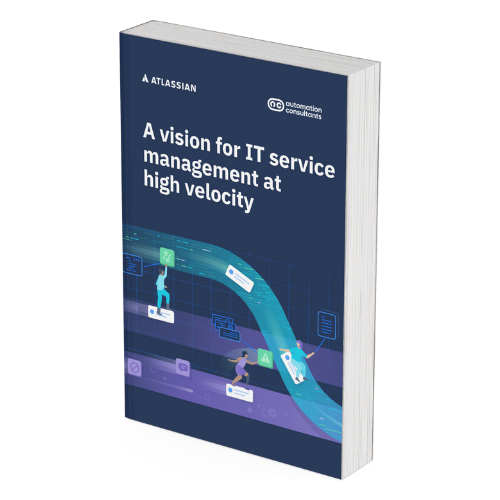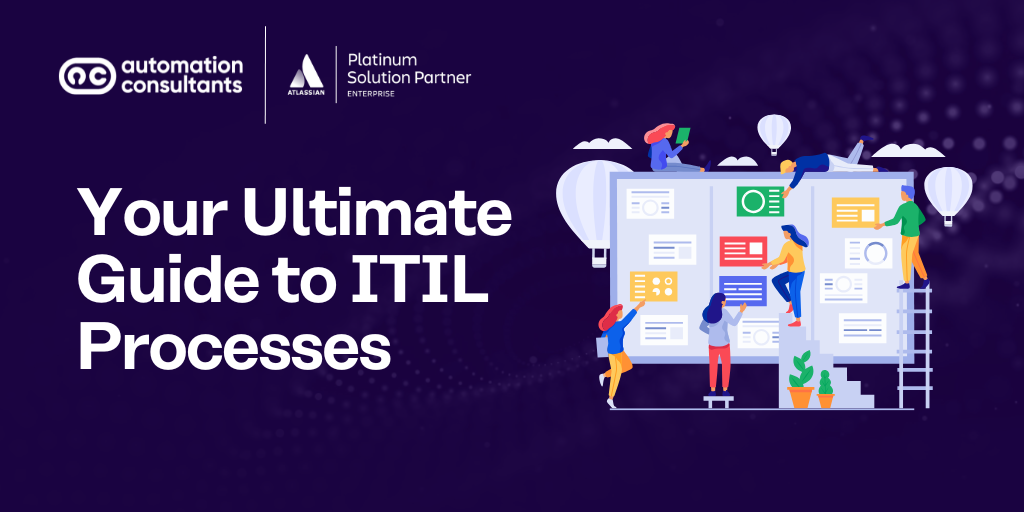For many of you working in the ITSM space, ITIL processes are a familiar presence.
In the day-to-day churn of tasks and requests, however, it’s all too easy to lose sight of the fundamental principles of this framework – and how it can enhance your IT Service Management design, delivery and support.
So, whether you’re here to simply refresh your understanding of ITIL processes, or you’re concerned that your ITSM provision isn’t as efficient or holistic as it should be, read on to learn how ITIL can impact your work. (As this is the Ultimate Guide, it’s a fairly long read. So could we suggest you make yourself a nice coffee too?)
We’ll cover:
- What is ITIL?
- Fundamental ITIL concepts
- Core processes
- Key functions
- The evolution of the Information Technology Infrastructure Library
- Spotlight on ITIL4
- Benefits of ITIL
- Challenges
When you truly understand and embed ITIL practices in your work, you’ll be better placed to align your IT services with business goals, improve efficiency, and avoid common pitfalls in ITIL adoption.
What is ITIL?
ITIL, or the Information Technology Infrastructure Library, is a framework that helps your organisation manage its IT services more effectively. It provides a set of best practices that align IT services with business goals and ensure you consistently deliver value to customers.
With this alignment, you can transform IT from a siloed department to an internal service that can connect with — and enhance — your teams’ work and output.
ITIL was originally developed by the UK government in the 1980s and has gained acceptance worldwide.
The framework has evolved since then, with ITIL 4 being the latest version. This newest iteration takes a more holistic approach. It emphasises flexibility, collaboration, and integration with modern Agile, DevOps, and Lean practices – again, all for that wider impact across your organisation
Differences between ITIL and ITSM
ITIL and ITSM are often mentioned together but are different. ITSM (IT Service Management), is a broad concept that encompasses all the activities, processes, and policies used to manage IT services throughout their lifecycle.
ITIL, meanwhile, is a specific framework and provides a set of best practices for implementing ITSM in a structured and consistent way.
Whilst ITSM is the overarching approach to managing IT services, ITIL offers detailed guidance on how to do this effectively. It covers areas like incident management, service continuity management, relationship management, and change management.
Think of ITSM as the ‘what’ — the overall approach to managing IT services — and ITIL as the ‘how’ — a framework that outlines the best practices.
Whilst you can implement ITSM without ITIL, using ITIL can significantly enhance the efficiency and effectiveness of your IT service management processes.
This guide offers a comprehensive exploration of achieving high velocity in ITSM. Download it now to transform how your team works and unlock new levels of efficiency and collaboration!

Fundamental ITIL concepts
To understand ITIL, you must first understand the fundamental concepts that form the backbone of the framework.
Now, ITIL’s scope is vast, and if we covered each concept and element in detail, this truly would be a behemoth of an article.
So, for the purposes of this guide, we’ve chosen three components worth noting at this stage:
1. The service lifecycle
One of the primary concepts in ITIL is the service lifecycle. This includes stages like:
Service strategy
Service design
Service transition
Service operation
Continual service improvement
These focus on different aspects of service management, from inception to ongoing refinement.
2. The four dimensions of service management
Another critical concept is the four dimensions of service management:
Organisations and people
Information and technology
Partners and suppliers
Value streams and processes
These dimensions ensure a balanced approach to service management. They consider all factors that impact service delivery.
3. Continual improvement
ITIL practices also value continual improvement. They encourage you to assess and enhance your business processes constantly, enabling your solutions or service delivery to remain effective and relevant.
We’ll explore wider elements of ITIL throughout these post, but these three concepts are a good starting point to illustrate both the scope and purpose of ITIL.
If you’re not confident that your team has adopted ITIL best practice successfully, or feel your processes and output need enhancing, why not talk to us?
As an Atlassian ITSM Specialized Partner, we’re uniquely qualified to guide you through the ITSM landscape – from best practice to tooling.
ITIL processes
It’s now time to turn our attention to ITIL processes.
Each process serves a specific purpose within the ITIL service lifecycle. When you embed these processes within your own ITSM offering, you can provide well-planned and well-designed IT services.
Key ITIL processes include:
Incident management: Focuses on restoring normal service operations as quickly as possible after a disruption to minimise the impact on business operations.
Change management: Introduces changes to IT services in a controlled and systematic way to reduce the risk of disruptions.
Problem management: Identifies and resolves the root causes of incidents, preventing future occurrences and improving service reliability.
Service level management: Manages agreements between IT and your organisation, ensuring that services meet agreed-upon performance standards.
Configuration management: Maintains accurate and reliable information about the IT infrastructure.
Service portfolio management and demand management: Manage the entire lifecycle of all services so that they meet current and future business requirements.
💡 Spotlight on JSM
Jira Service Management (JSM) is Atlassian’s flagship ITSM platform, and can fulfil core ITIL processes and a rich range of use cases.
We recently explored these use cases in ‘What is Jira Service Management’, where we took a comprehensive look at JSM’s capabilities across Incident and Problem Management, Knowledge Management and more.
ITIL functions
Whilst the processes above should drive your IT Service Management, it’s the ITIL functions that ensure these processes are carried out effectively.
Key ITIL functions include:
Service desk: Your Service Desk is, of course, the primary point of contact between users and your organisation’s IT provision. It handles incidents, service requests, and user communications, ensuring quick resolution and customer satisfaction.
Technical management: This function manages the IT infrastructure, including hardware, software, and networks. The technical management team keeps the infrastructure stable, secure and supports your organisation’s needs.
Application management: Focused on managing applications’ lifecycles, this function oversees the design, testing, deployment, and ongoing maintenance of software applications that support business operations.
IT operations management: This function handles the day-to-day activities needed to manage and maintain the IT environment. It includes tasks such as monitoring system performance, managing backups, and ensuring that IT services are available and reliable.
The evolution of ITIL
It’s always helpful to understand the origins of a framework – particularly when it so deeply informs the way you manage your ITSM.
The first version of ITIL, launched in 1989, consisted of a collection of books. Each of these focused on a specific aspect of IT Service Management.
As it became more popular, ITIL was refined and expanded. In 2001, a more cohesive and streamlined V2 was launched.
That was followed by V3 in 2007, which introduced the concept of the Service Lifecycle. This concept provided a more holistic view of IT Service Management by focusing on the entire lifecycle of IT services, from strategy to continuous improvement, as outlined in ITIL v3.
The most recent iteration, ITIL 4, was released in 2019. It represents a major shift, embracing modern Agile, DevOps and Lean practices. It also introduced the Service Value System (SVS).
What is ITIL 4?
ITIL 4 was designed to better align with today’s business environments. Unlike its predecessors, it introduces a more flexible, adaptable approach which emphasises collaboration, automation, and continual improvement.
‘The main aim of ITIL4 was to re-align the philosophy, and move away from traditional processes to value-driven delivery more closely aligned with Agile, DevOps and Lean practices.
The biggest change was the addition of the Service Value Stream, which is now directly supported by the guiding principles.’
– Senior Consultant at AC
💡 Spotlight on the Service Value Chain in ITIL 4
The Service Value Chain is a core component of ITIL 4 and represents an organisation’s activities to create value through IT services.
Unlike the linear models of previous ITIL versions, the SVS is flexible and adaptable. It allows organisations to design workflows that meet their unique needs and objectives.
At the heart of the service value chain are six key activities:
Plan: This activity involves understanding the organisation’s vision, current state, and direction. Planning ensures that IT services align with business objectives and that there is a clear strategy for service management.
Improve: Continual improvement is embedded in the framework, and this activity focuses on enhancing products, services, and practices. The goal is to ensure your organisation evolves to meet changing needs and expectations.
Engage: Interactions with customers, users, and other stakeholders help your business understand its needs, expectations, and feedback. Effective engagement ensures that services are designed and delivered to meet customer requirements.
Design and transition: This activity focuses on developing and deploying new or changed services into operation. It ensures that services are fit for purpose, meet quality standards, and are ready for live environments.
Obtain/build: This involves acquiring or building the necessary service components, developed in-house or procured from external suppliers. The goal is to ensure all components are available and ready for integration.
Deliver and support: This activity covers the day-to-day delivery of services, including managing operations, supporting users, and maintaining service levels. It ensures that services are delivered as expected and that any issues are promptly addressed.
These six activities are interconnected, forming a dynamic and flexible system that can be tailored to meet specific organisational needs.
Benefits of ITIL adoption
Whether your organisation is large or small, ITIL provides a flexible and scalable framework tailored to your unique needs. So, why implement ITIL practices?
Improved service quality: One of the primary benefits of ITIL adoption is improving the quality of your IT services through effective service validation and testing. By following ITIL’s best practices, you can keep your services reliable, consistent, and aligned with user expectations. This, of course, leads to greater customer satisfaction and enhances your organisation’s reputation.
Increased efficiency and productivity: Standardised processes and practices help you reduce, if not eliminate entirely, inefficiencies. Streamlined service management activities help you improve productivity, reduce operational costs and optimise your resources.
Enhanced risk management: A structured approach to risk management helps your organisation identify, assess, and mitigate potential issues before they impact service delivery to reduce the likelihood of service disruptions and make services more resilient.
Better alignment with business objectives: IT services designed and delivered in line with strategic goals support business growth, enhance competitiveness, and drive innovation.
Continuous improvement: Regular evaluation and refinement of your IT services keep them relevant, efficient and effective, even as business needs evolve.
Enhanced customer and stakeholder satisfaction: Improved service quality, increased efficiency, and IT operations that support business priorities keep customers and stakeholders happy. Satisfied customers are more likely to remain loyal and recommend your services to others.
Are you ready to adopt ITIL4 and enhance your IT service strategy, design, delivery and support? Turn to us for dedicated ITSM consultancy from a trusted Atlassian ITSM Specialized Partner.
Common mistakes to avoid for seamless ITIL adoption
Over the years we’ve noted a number of common mistakes that organisations encounter during their ITIL framework implementations. The good news is, we can share these challenges with you and share how you can successfully overcome them.
Overlooking organisational readiness: One of the most common mistakes is failing to assess whether your organisation is ready for ITIL.
Focus on your pain points first (perhaps consider undertaking an internal assessment), and then look for the elements of ITIL which will support those challenges – rather than trying to adopt 40+ new processes.
It’s also valuable to ensure that your team understands that changes are coming, and that stakeholders are prepared for the shift. Invest in training and awareness to help mitigate resistance and confusion.
Neglecting to start where you are: ITIL encourages organisations to build on existing processes rather than starting from scratch.
We’ve seen organisations disregard their current practices that work well. Assess what’s already in place and build on those strengths to ease the transition.
Lack of clear communication and collaboration: Effective communication is key to a seamless adoption. All stakeholders should be aligned, and goals, roles and responsibilities should be communicated. If you actively promote collaboration across teams, this help break down silos and foster a unified approach to IT service management.
Failing to prioritise continuous improvement: Another mistake is adopting ITIL as a one-time initiative rather than an ongoing process. Embrace continual improvement by regularly reviewing and refining practices to align them with evolving business needs.
Overcomplicating the transition: ITIL 4 advises keeping processes simple and practical. Avoid overcomplicating the adoption with unnecessary steps or overly complex procedures. Focus on what’s essential and implement changes incrementally.
Selecting the right tools: Ineffective tools can lead to misaligned processes, inefficiencies, and a failure to realise the full benefits of ITIL. Ensure that your toolset is fit for purpose and supports the specific needs of your IT service management framework.
Jira Service Management is a full-service ITSM tool, designed to deliver holistic, collaborative and efficient IT services. From migration services and implementation to JSM configuration, we can support you on your ITSM tooling journey.
Looking ahead: ITIL and the future
As we often reference here on the AC blog, we’re experiencing a period of great – perhaps unprecedented – change.
So, there’s a question as to whether frameworks, like ITIL, can keep pace with these changes and continue to fulfil the needs of users.
We turned to our Consultancy Team to ask for their thoughts.
‘The current frameworks stand up well to large industry changes. By design hey are robust and agnostic. AI will be a facilitator in a lot of these processes, allowing automation where possible which is a key practice within ITIL. With the addition of this extra assistance and removal of technical debt, the focus of the service desk, in particular, shifts to supporting the customer and end users as people, rather than the technical query they have raised.’ – Senior Consultant, AC
Enhance your ITSM - today and tomorrow
Here at AC, we’re dedicated to guiding our clients to long-term success.
Whether that’s providing a health-check of your current ITSM tooling, supporting you to implement ITIL across your team, or reviewing and optimising your processes, we’re here to help.
Benefit from a free consultation!
With our free consultation initiative, you can discuss your project aims, challenges and concerns with one of our expert consultants. Completely free, and with no obligation, you’ll have access to a dedicated consultant for half an hour, who can listen to your requirements and guide you through initial recommendations.





